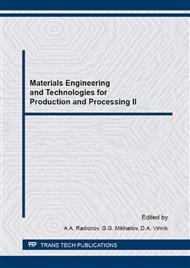[1]
T. Morinaga, T. Minegishi, H. Watanabe, A Study of Crack Formation in the Light Alloys Casting, in: Proceedings of the International Congress of Casters, Amsterdam. (1967) 88-93.
Google Scholar
[2]
H.F. Hall, Iron and Steel Inst, Report no 23, (1938).
Google Scholar
[3]
L.A. Shcheglovitov, A.A. Divavin, The Device for the Study of Linear Shrinkage and Crack Resistance of Casting Steels, Liteinoye proizvodstvo. 2 (1980) 19-20.
Google Scholar
[4]
Yu.S. Gomelskiy, Yu.N. Antyukhov, V.N. Borovitskiy, On the Strength Testing of Molding and Core Mixtures, Liteinoye proizvodstvo. 1 (1982).
Google Scholar
[5]
K.N. Vdovin, A.S. Savinov, N.A. Feoktisov, Prediction of Crack Resistance of Large Steel Castings, Liteinoye proizvodstvo. 12 (2014) 8-10.
Google Scholar
[6]
V.I. Shvetsov, B.A. Kulakov, M.A. Ivanov, Features of Production of Steel Castings: Monograph, SUSU, Chelyabinsk, (2014).
Google Scholar
[7]
V.A. Smolko, Ye.G. Antoshkina, Estimated Analytical Expressions of the Thermodynamic Parameters of Moulds and Spindles Made of Synthetic Mixtures with Allowance for Anharmonicity, Bulletin of the South Ural State University, Series: Metallurgy. 15 (2015).
DOI: 10.14529/met150408
Google Scholar
[8]
V.A. Smolko, Ye.G. Antoshkina, Prediction of the Reliability of Moulds and Spindles Made of Synthetic Mixtures with Allowance for Anharmonicity, in: Proceedings of the XII International Congress of Casters, NGTU, Nizhny Novgorod. (2015) 385-391.
Google Scholar
[9]
V.M. Kolokoltsev, A.S. Savinov, Ye.V. Sinitskiy, Modelling of Temperature Fields in the Production of Castings, Vestnik of Nosov Magnitogorsk State Technical University. 3 (2015) 39-43.
Google Scholar
[10]
A.S. Savinov, A.S. Tuboltseva, D.V. Varlamova, Calculation of Thermal Field of Raw Sand and Clay Moulds, Chernye Metally (Ferrous metals). (2011) 36-38.
Google Scholar
[11]
A.S. Savinov, A.S. Tuboltseva, Ye.V. Sinitskiy, Analysis of Power Interaction Between the Mould and the As-cast Part, Proceedings of the Samara Scientific Center of the Russian Academy of Sciences. (2011) 623-626.
Google Scholar
[12]
K.N. Vdovin, K.G. Pivovarova, M.A. Lisovskaya, The Use of Thermal Analysis to Study the Structure and Properties of Roll Steels, Metal Science and Heat Treatment. 56 (2014) 302-305.
DOI: 10.1007/s11041-014-9750-9
Google Scholar
[13]
V.M. Kolokoltcev, A.S. Savinov, The Simulation of the Carbon Steel Deformation Resistance in the Brittleness Temperature Range, Czestochowa University of Technology, Faculty of Production Engineering and Materials Technology, Czestochowa, (2014).
Google Scholar
[14]
V.M. Kolokoltsev, E.V. Petrochenko, O.A. Mironov, Influence of the Chemical Composition on the Structure Formation and Properties of Temperature- and Wear-Resistant Cast Iron, Steel in Translation. 37 (2007) 229-233.
DOI: 10.3103/s0967091207030138
Google Scholar
[15]
A.S. Savinov, V.M. Kolokoltcev, К.N. Vdovin, N.А. Feoktistov, Determination of Internal Forces in the Cooled Walls of the Casting in the Implementation of Asymmetric Elements Difficulties, in: Proceeding of European Conference on Innovations in Technical and Natural Sciences, the 5th International scientific conference, Vienna. (2014).
Google Scholar
[16]
V.M. Kolokoltsev, A.S. Savinov, F.G. Ibragimov, Identification of Thermal Stresses in a Temperature Gradient in the Flat Wall of the Casting, Stal. 4 (2014) 21-24.
Google Scholar
[17]
V.M. Kolokoltsev, Effect of Chemical Composition and Cooling Conditions on Alloyed White Iron Microstructure and Properties, Metallurgist. 58 (2014) 294-298.
DOI: 10.1007/s11015-014-9904-4
Google Scholar
[18]
N. Yu. Tayts, Heating technology steel, Metallurgizdat, Moscow, (1962).
Google Scholar
[19]
V.M. Kolokoltsov, Z. Konopka, Stress Analysis of Castings when Producing a Cavity with a Cylindrical Core, in: Proceedings of XV International Scientific Conference: New Technologies and Achievements in Metallurgy, Material Engineering and Production Engineering, Czestochowa. (2015).
Google Scholar
[20]
A.S. Savinov, Calculation on the Strength of the Casting when Forming its Cavity with a Cylindrical Spindle, Izvestiya: Ferrous Metallurgy. 1 (2016) 39-42.
Google Scholar
[21]
A.S. Savinov, The Calculation of the Stress State at Introducing Asymmetric Problem Elements of As-cast Part into the Variable Rigidity Sand Layer, Vestnik of Nosov Magnitogorsk State Technical University. 3 (2015) 64-70.
Google Scholar


